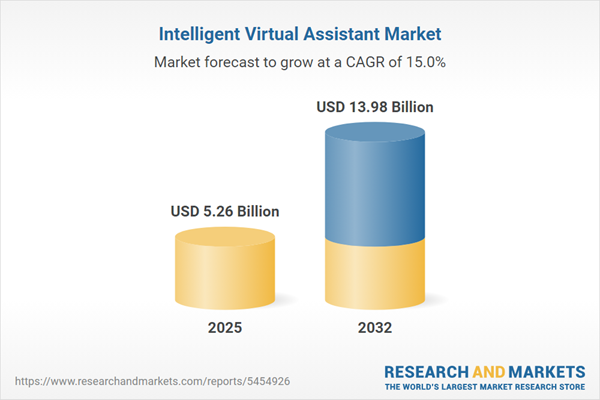Speak directly to the analyst to clarify any post sales queries you may have.
The intelligent virtual assistant market is rapidly redefining how enterprises automate workflows and streamline day-to-day processes, cementing digital solutions as crucial tools in modern strategies. As organizations seek stronger integration and operational efficiency, these assistants present tangible business value.
Intelligent Virtual Assistant Market Snapshot
Driven by continuous progress in machine learning, robotics, natural language processing, and speech recognition, the intelligent virtual assistant market is experiencing robust expansion. Senior decision-makers in sectors such as finance, healthcare, manufacturing, retail, and government are deploying these technologies to reduce manual effort, elevate service quality, and improve operational workflows. Enhanced conversational understanding and tailored domain expertise are expanding intelligent virtual assistant adoption. This momentum is prompting organizations to focus on seamless integration, data privacy, and compliance, given the evolving information technology environment. As digital transformation matures, virtual assistants serve as essential catalysts, enabling future-ready operating models and continuous improvement.
Scope & Segmentation in the Intelligent Virtual Assistant Market
The report equips senior executives with a comprehensive framework for evaluating intelligent virtual assistant solutions within digital transformation strategies. Key segmentation options guide investment decisions and long-term planning:
- Offering Types: Hardware powers core enterprise devices, while software and managed services enable analytics-driven automation and effective IT process management.
- Technologies: Robotics, computer vision, adaptive machine learning, advanced speech and language processing, and integrated video analytics directly enhance accuracy and productivity in enterprise environments.
- Deployment Modes: Public and private cloud, on-premises, and hybrid setups provide essential options for security, flexibility, and compliance across varied organization types.
- Applications: Virtual assistants increasingly support customer engagement, predictive insights, fraud prevention, and automation of targeted workflows, delivering measurable process benefits.
- Industry Verticals: Key sectors are banking, financial services, insurance, government, defense, healthcare, manufacturing, and retail—where process optimization and regulatory compliance are critical.
- Regions: Market growth reflects infrastructure sophistication, policy requirements, and linguistic diversity. North America, Europe, and China stand out in adoption, while local innovation and policy shifts shape the Americas, EMEA, and Asia-Pacific regions.
- Key Competitors: Major players include Google LLC, Amazon.com, Inc., Apple Inc., Microsoft Corporation, Samsung Electronics Co., Ltd., Baidu, Inc., Alibaba Group Holding Limited, Xiaomi Corporation, SoundHound AI, Inc., and IBM Corporation.
Key Takeaways for Decision-Makers
- Intelligent virtual assistants directly integrate with daily enterprise operations, promoting more responsive communication and streamlined workflows across business functions.
- Selecting adaptable deployment strategies—spanning cloud, edge, or on-premises—maximizes security, scalability, and operational flexibility for diverse teams and stakeholders.
- Maintaining a dedicated focus on data security and regulatory compliance enables organizations to respond proactively to shifting legal frameworks and industry-specific mandates.
- Customizing language capabilities and solution features improves adoption rates in regions and sectors with unique workflows or compliance requirements.
- Strategic partnerships and targeted employee enablement unlock further process improvement and accelerate the value derived from intelligent virtual assistant deployments.
- Leveraging conversational analytics generates actionable insights, fueling ongoing process optimization and nurturing enterprise agility in changing markets.
Tariff Impact on the Intelligent Virtual Assistant Ecosystem
Recent changes in U.S. tariffs have reshaped hardware procurement and supply chains, prompting many service providers to shift toward regional manufacturing and expanded supplier partnerships. At the same time, software and platform vendors are refining system design and reworking pricing models to reduce volatility and mitigate the impact of trade dynamics. These combined developments support greater resilience across the intelligent virtual assistant ecosystem, helping enterprises manage a complex and evolving supply environment.
Methodology & Data Sources
This research is based on vetted insights from senior executives, in-depth segmentation, and strategic vendor evaluations. All data are independently validated, ensuring reliable technology assessment and informed decision-making at the enterprise level.
Why This Report Matters
- Senior leaders gain clear and actionable analysis to align intelligent virtual assistant adoption with changing compliance standards and digital transformation objectives.
- The structured approach offers support for risks, regulatory planning, and agile adaptation in complex B2B settings.
- Scenario-driven recommendations enhance organizational resilience, competitiveness, and business growth despite continuous market change.
Conclusion
By applying insights from this report, executives can accelerate adoption, reinforce enterprise consistency, and unlock growth opportunities through ongoing process improvement.
Additional Product Information:
- Purchase of this report includes 1 year online access with quarterly updates.
- This report can be updated on request. Please contact our Customer Experience team using the Ask a Question widget on our website.
Table of Contents
3. Executive Summary
4. Market Overview
7. Cumulative Impact of Artificial Intelligence 2025
Companies Mentioned
The companies profiled in this Intelligent Virtual Assistant market report include:- Google LLC
- Amazon.com, Inc.
- Apple Inc.
- Microsoft Corporation
- Samsung Electronics Co., Ltd.
- Baidu, Inc.
- Alibaba Group Holding Limited
- Xiaomi Corporation
- SoundHound AI, Inc.
- IBM Corporation
Table Information
| Report Attribute | Details |
|---|---|
| No. of Pages | 192 |
| Published | October 2025 |
| Forecast Period | 2025 - 2032 |
| Estimated Market Value ( USD | $ 5.26 Billion |
| Forecasted Market Value ( USD | $ 13.98 Billion |
| Compound Annual Growth Rate | 15.0% |
| Regions Covered | Global |
| No. of Companies Mentioned | 11 |









